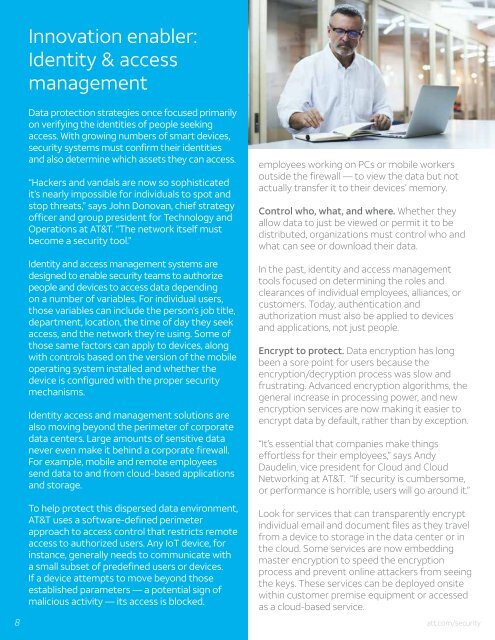The CEO’s Guide to Data Security
2mRmvHx
2mRmvHx
Create successful ePaper yourself
Turn your PDF publications into a flip-book with our unique Google optimized e-Paper software.
Innovation enabler:<br />
Identity & access<br />
management<br />
8<br />
<strong>Data</strong> protection strategies once focused primarily<br />
on verifying the identities of people seeking<br />
access. With growing numbers of smart devices,<br />
security systems must confirm their identities<br />
and also determine which assets they can access.<br />
“Hackers and vandals are now so sophisticated<br />
it’s nearly impossible for individuals <strong>to</strong> spot and<br />
s<strong>to</strong>p threats,” says John Donovan, chief strategy<br />
officer and group president for Technology and<br />
Operations at AT&T. “<strong>The</strong> network itself must<br />
become a security <strong>to</strong>ol.”<br />
Identity and access management systems are<br />
designed <strong>to</strong> enable security teams <strong>to</strong> authorize<br />
people and devices <strong>to</strong> access data depending<br />
on a number of variables. For individual users,<br />
those variables can include the person’s job title,<br />
department, location, the time of day they seek<br />
access, and the network they’re using. Some of<br />
those same fac<strong>to</strong>rs can apply <strong>to</strong> devices, along<br />
with controls based on the version of the mobile<br />
operating system installed and whether the<br />
device is configured with the proper security<br />
mechanisms.<br />
Identity access and management solutions are<br />
also moving beyond the perimeter of corporate<br />
data centers. Large amounts of sensitive data<br />
never even make it behind a corporate firewall.<br />
For example, mobile and remote employees<br />
send data <strong>to</strong> and from cloud-based applications<br />
and s<strong>to</strong>rage.<br />
To help protect this dispersed data environment,<br />
AT&T uses a software-defined perimeter<br />
approach <strong>to</strong> access control that restricts remote<br />
access <strong>to</strong> authorized users. Any IoT device, for<br />
instance, generally needs <strong>to</strong> communicate with<br />
a small subset of predefined users or devices.<br />
If a device attempts <strong>to</strong> move beyond those<br />
established parameters — a potential sign of<br />
malicious activity — its access is blocked.<br />
employees working on PCs or mobile workers<br />
outside the firewall — <strong>to</strong> view the data but not<br />
actually transfer it <strong>to</strong> their devices’ memory.<br />
Control who, what, and where. Whether they<br />
allow data <strong>to</strong> just be viewed or permit it <strong>to</strong> be<br />
distributed, organizations must control who and<br />
what can see or download their data.<br />
In the past, identity and access management<br />
<strong>to</strong>ols focused on determining the roles and<br />
clearances of individual employees, alliances, or<br />
cus<strong>to</strong>mers. Today, authentication and<br />
authorization must also be applied <strong>to</strong> devices<br />
and applications, not just people.<br />
Encrypt <strong>to</strong> protect. <strong>Data</strong> encryption has long<br />
been a sore point for users because the<br />
encryption/decryption process was slow and<br />
frustrating. Advanced encryption algorithms, the<br />
general increase in processing power, and new<br />
encryption services are now making it easier <strong>to</strong><br />
encrypt data by default, rather than by exception.<br />
“It’s essential that companies make things<br />
effortless for their employees,” says Andy<br />
Daudelin, vice president for Cloud and Cloud<br />
Networking at AT&T. “If security is cumbersome,<br />
or performance is horrible, users will go around it.”<br />
Look for services that can transparently encrypt<br />
individual email and document files as they travel<br />
from a device <strong>to</strong> s<strong>to</strong>rage in the data center or in<br />
the cloud. Some services are now embedding<br />
master encryption <strong>to</strong> speed the encryption<br />
process and prevent online attackers from seeing<br />
the keys. <strong>The</strong>se services can be deployed onsite<br />
within cus<strong>to</strong>mer premise equipment or accessed<br />
as a cloud-based service.<br />
att.com/security



